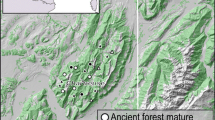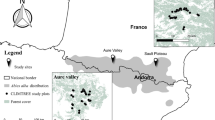Abstract
It is often suggested that habitat attributes and interspecific interactions can cause non-random species co-occurrence patterns, but quantifying their contributions can be difficult. Null models that systematically exclude and include habitat effects can give information on the contribution of these factors to community assembly. In the boreal forest, saproxylic beetles are known to be attracted to recently burned forests where they breed in dead and dying trees. We examined whether species co-occurrences of saproxylic beetles that develop in, and emerge from, boles of recently burned trees show non-random patterns. We also estimated the extent to which both the post-fire habitat attributes and interspecific interactions among beetles contribute to such patterns. We sampled tree boles encompassing key attributes (tree species, tree size/dbh and burn severity) that are thought to characterize species–habitat associations of saproxylic beetles, a proposition that we tested using indicator species analysis. Two null models with no habitat constraints (“unconstrained”) indicated that a total of 29.4% of the species pairs tested had significant co-occurrence patterns. Habitat-constrained null models indicated that most of the detected species aggregations (72%) and segregations (59%) can be explained by shared and distinct species–habitat relationships, respectively. The assembly pattern was also driven by interspecific interactions, of which some were modulated by habitat; for example, predator and prey species tended to co-occur in large-sized trees (a proxy of available bark/wood food resource primarily for the prey). In addition, some species segregation suggesting antagonistic, competitive, or prey–predator interactions were evident after accounting for the species’ affinities for the same tree species. Overall, our results suggest that an intimate link between habitat and interspecific interactions can have important roles for community assembly of saproxylic assemblages even following disturbance by fire. We also show that a systematic application of null models can offer insight into the mechanisms behind the assembly of ecological communities.


Similar content being viewed by others
References
Allison JD, Borden JH, McIntosh RL, De Groot P, Gries R (2001) Kairomonal response by four Monochamus species (Coleoptera: Cerambycidae) to bark beetle pheromones. J Chem Ecol 27:633–646
Allison JD, Borden JH, Seybold SJ (2004) A review of the chemical ecology of the Cerambycidae (Coleoptera). Chemoecology 14:123–150
Azeria ET (2004) Community dynamics of insular biotas in space and time. PhD thesis, Swedish University of Agricultural Sciences, Uppsala
Azeria ET, Fortin D, Hébert C, Peres-Neto P, Pothier D, Ruel J-C (2009a) Using null model analysis of species co-occurrences to deconstruct biodiversity patterns and select indicator species. Divers Distrib 15:958–971
Azeria ET, Fortin D, Lemaître J, Janssen P, Hébert C, Darveau M, Cumming SG (2009b) Fine-scale structure and cross-taxon congruence of bird and beetle assemblages in an old-growth boreal forest mosaic. Glob Ecol Biogeogr 18:333–345
Azeria ET, Bouchard M, Pothier D, Fortin D, Hébert C (2011) Using biodiversity deconstruction to disentangle assembly and diversity dynamics of understorey plants along post fire succession in boreal forest. Glob Ecol Biogeogr 20:119–133
Bergström U, Englund G (2002) Estimating predation rates in experimental systems: scale-dependent effects of aggregative behaviour. Oikos 97:251–259
Boucher J (2011) Impacts de la coupe de récupération après feu sur les coléoptéres associés aux brûlis en forêt boréale: une dynamque temporaelle. Master thesis, Université du Québec à Chicoutimi, Chicoutimi
Boulanger Y, Sirois L (2007) Postfire succession of saproxylic arthropods, with emphasis on Coleoptera, in the north boreal forest of Quebec. Environ Entomol 36:128–141
Boulanger Y, Sirois L, Hébert C (2010) Distribution of saproxylic beetles in a recently burnt landscape of the northern boreal forest of Québec. For Ecol Manag 260:1114–1123
Bowker MA, Soliveres S, Maestre FT (2010) Competition increases with abiotic stress and regulates the diversity of biological soil crusts. J Ecol 980:551–560
Callaway R, Walker L (1997) Competition and facilitation: a synthetic approach to interactions in plant communities. Ecology 78:1958–1965
Chase JM, Abrams PA, Grover JP, Diehl S, Chesson P, Holt RD, Richards SA, Nisbet RM, Case TJ (2002) The interaction between predation and competition: a review and synthesis. Ecol Lett 5:302–315
Connell JH (1980) Diversity and the coevolution of competitors, or the ghost of competition past. Oikos 35:131–138
Connor EF, Simberloff D (1979) The assembly of species communities: chance or competition? Ecology 60:1132–1140
Connor EF, Simberloff D (1983) Interspecific competition and species co-occurrence patterns on islands: null models and the evaluation of evidence. Oikos 41:455–465
Coulson RN, Mayyasi AM, Foltz JL, Hain FP (1976) Interspecific competition between Monochamus titillator and Dendroctonus frontalis. Environ Entomol 5:235–247
De Cáceres M, Legendre P (2009) Associations between species and groups of sites: indices and statistical inference. Ecology 90:3566–3574
Diamond JM (1975) Assembly of species communities. In: Cody ML, Diamond JM (eds) Ecology and evolution of communities. Harvard University Press, Cambridge, pp 342–444
Dice LR (1945) Measures of the amount of ecologic association between species. Ecology 26:297–302
Dodds KJ, Graber C, Stephen FM (2001) Facultative intraguild predation by larval Cerambycidae (Coleoptera) on bark beetle larvae (Coleoptera: Scolytidae). Environ Entomol 30:17–22
Gotelli NJ (2000) Null model analysis of species co-occurrence patterns. Ecology 81:2606–2621
Gotelli NJ (2001) Research frontiers in null model analysis. Glob Ecol Biogeogr 10:337–343
Gotelli NJ, Entsminger GL (2001) Swap and fill algorithms in null model analysis: rethinking the knight’s tour. Oecologia 129:281–291
Gotelli NJ, Graves GR (1996) Null models in ecology. Smithsonian Institution, Washington
Gotelli NJ, McCabe DJ (2002) Species co-occurrence: a metaanalysis of J. M. Diamond’s assembly rules model. Ecology 83:2091–2096
Gotelli NJ, Ulrich W (2010) The empirical Bayes approach as a tool to identify non-random species associations. Oecologia 162:463–477
Gotelli NJ, Buckley NJ, Wiens JA (1997) Co-occurrence of Australian land birds: Diamond’s assembly rules revisited. Oikos 80:311–324
Grove SJ (2002) Saproxylic insect ecology and the sustainable management of forests. Annu Rev Ecol Syst 33:1–23
Harvey PH, Colwell RK, Silverton JW, May RM (1983) Null models in ecology. Annu Rev Ecol Syst 14:189–211
Holt RD (1984) Spatial heterogeneity, indirect interactions, and the coexistence of prey species. Am Nat 124:377–406
Hughes AR, Grabowski JH (2006) Habitat context influences predator interference interactions and the strength of resource partitioning. Oecologia 149:256–264
Jaccard P (1901) Etude comparative de la distribution florale dans une portion des Alpes et des Jura. Bull Soc Vaudoise Sci Nat 37:547–579
Jackson DA, Somers KM, Harvey HH (1992) Null models and fish communities: evidence of nonrandom patterns. Am Nat 139:930–951
Jeffries MJ, Lawton JH (1984) Enemy free space and the structure of ecological communities. Biol Linn Soc 23:269–286
Kenis M, Wermelinger B, Grégoire J-C (2004) Research on parasitoids and predators of Scolytidae, a review. In: Lieutier F, Day KR, Battisti A, Grégoire J-C, Evans HF (eds) Bark and wood boring insects in living trees in Europe, a synthesis. Kluwer, Dordrecht, pp 237–290
Lassau SA, Hochuli DF, Cassis G, Reid CAM (2005) Effects of habitat complexity on forest beetle diversity: do functional groups respond consistently? Divers Distrib 11:73–82
MacArthur RH, Wilson EO (1967) The theory of island biogeography. Princeton University Press, Princeton
Maltez-Mouroa S, Maestre FT, Freitasa H (2010) Co-occurrence patterns and abiotic stress in sand-dune communities: their relationship varies with spatial scale and the stress estimator. Acta Oecol 36:80–84
McCullough DG, Werner RA, Neumann D (1998) Fire and insects in northern and boreal forest ecosystems of North America. Annu Rev Entomol 43:107–127
Miklós I, Podani J (2004) Randomization of presence–absence matrices: comments and new algorithms. Ecology 85:86–92
Oksanen J, Kindt R, Legendre P, O’Hara B, Henry M, Stevens MHH, Wagner, H (2010) Vegan: community ecology package. http://cran.R-project.org/web/packages/vegan (accessed 30 April 2010)
Ovaskainen O, Hottola J, Siitonen J (2010) Modeling species co-occurrence by multivariate logistic regression generates new hypotheses on fungal interactions. Ecology 91:2514–2521
Peres-Neto PR (2004) Patterns in the co-occurrence of fish species in streams: the role of site suitability, morphology and phylogeny versus species interactions. Oecologia 140:352–360
Peres-Neto PR, Olden JD, Jackson DA (2001) Environmentally constrained null models: site suitability as occupancy criterion. Oikos 93:110–120
Pitzalis MA, Luiselli L, Bologna M (2010) Co-occurrence analyses show that non-random community structure is disrupted by fire in two groups of soil arthropods (Isopoda Oniscidea and Collembola). Acta Oecol 36:100–106
R Development Core Team (2010) R: A language and environment for statistical computing. R Foundation for Statistical Computing, Vienna, Austria. http://cran.r-project.org/
Raffa KF, Dahlsten DL (1995) Differential responses among natural enemies and prey to bark beetle pheromones. Oecologia 102:17–23
Rejmánek M, Lepš J (1996) Negative associations can reveal interspecific competition and reversal of competitive hierarchies during succession. Oikos 76:161–168
Rosenzweig ML (1995) Species diversity in space and time. Cambridge University Press, New York
Saint-Germain M, Drapeau P, Hébert C (2004a) Landscape-scale habitat selection patterns of Monochamus scutellatus (Coleoptera: Cerambycidae) in a recently burned black spruce forest. Environ Entomol 33:1703–1710
Saint-Germain M, Drapeau P, Hébert C (2004b) Xylophagous insect species composition and patterns of substratum use on fire-killed black spruce in central Quebec. Can J For Res 34:677–685
Sanderson JG (2000) Testing ecological patterns. Am Sci 88:332–339
Sanderson JG (2004) Null model analysis of communities on gradients. J Biogeogr 31:879–883
Sara M, Bellia E, Milazzo A (2006) Fire disturbance disrupts co-occurrence patterns of terrestrial vertebrates in Mediterranean woodlands. J Biogeogr 33:843–852
Savely HE Jr (1939) Ecological relations of certain animals in dead pine and oak logs. Ecol Monogr 9:321–385
Sfenthourakis S, Tzanatos E, Giokas S (2006) Species co-occurrence: the case of congeneric species and a causal approach to patterns of species association. Glob Ecol Biogeogr 15:39–49
Stone L, Roberts A (1990) The checkerboard score and species distributions. Oecologia 85:74–79
Stone L, Roberts A (1992) Competitive exclusion, or species aggregation? An aid in deciding. Oecologia 91:419–424
Ulrich W (2004) Species co-occurrences and neutral models: reassessing J. M. Diamond’s assembly rules. Oikos 107:603–609
Wilson JB (1987) Methods for detecting non-randomness in species co-occurrences: a contribution. Oecologia 73:579–582
Wright SJ, Biehl CC (1982) Island biogeographic distributions: testing for random regular, and aggregated patterns of species co-occurrence. Am Nat 119:345–357
Zaman A, Simberloff D (2002) Random binary matrices in biogeographical ecology—instituting a good neighbor policy. Environ Ecol Stat 9:405–421
Acknowledgments
We thank Chantiers Chibougamau and Barrette Chapais Ltée for logistical support, and F. Bélanger, S. Bélanger, J. Boucher, S. Bourque, C. Buidin, C. Caron, M. Couture, M. Huot, O. Jeffrey, Y. Rochepault, A. Sanfacon, M.-C. Saulnier, J. Simard-Nadeau and M.-A. Valiquette for their help in conducting the field work and in sample sorting. We are indebted to Y. Dubuc and G. Pelletier for specimen identification. This paper has benefited greatly from the insightful comments and suggestions made by C. Boisvenue, Y. Boulanger and three anonymous reviewers. We also thank P. Cheers for revising the English. This study was supported by the Fonds de recherche sur la nature et les technologies and the Ministère des Ressources naturelles et de la Faune through the Programme de recherche en partenariat sur l’aménagement et l’environnement forestiers-II, by the iFor consortium (Université Laval), by Environment Canada, by the Canadian Forest Service, and by la Fondation de l’Université du Québec à Chicoutimi.
Author information
Authors and Affiliations
Corresponding author
Additional information
Communicated by Sven Bacher.
Electronic supplementary material
Below is the link to the electronic supplementary material.
Rights and permissions
About this article
Cite this article
Azeria, E.T., Ibarzabal, J. & Hébert, C. Effects of habitat characteristics and interspecific interactions on co-occurrence patterns of saproxylic beetles breeding in tree boles after forest fire: null model analyses. Oecologia 168, 1123–1135 (2012). https://doi.org/10.1007/s00442-011-2180-0
Received:
Accepted:
Published:
Issue Date:
DOI: https://doi.org/10.1007/s00442-011-2180-0




